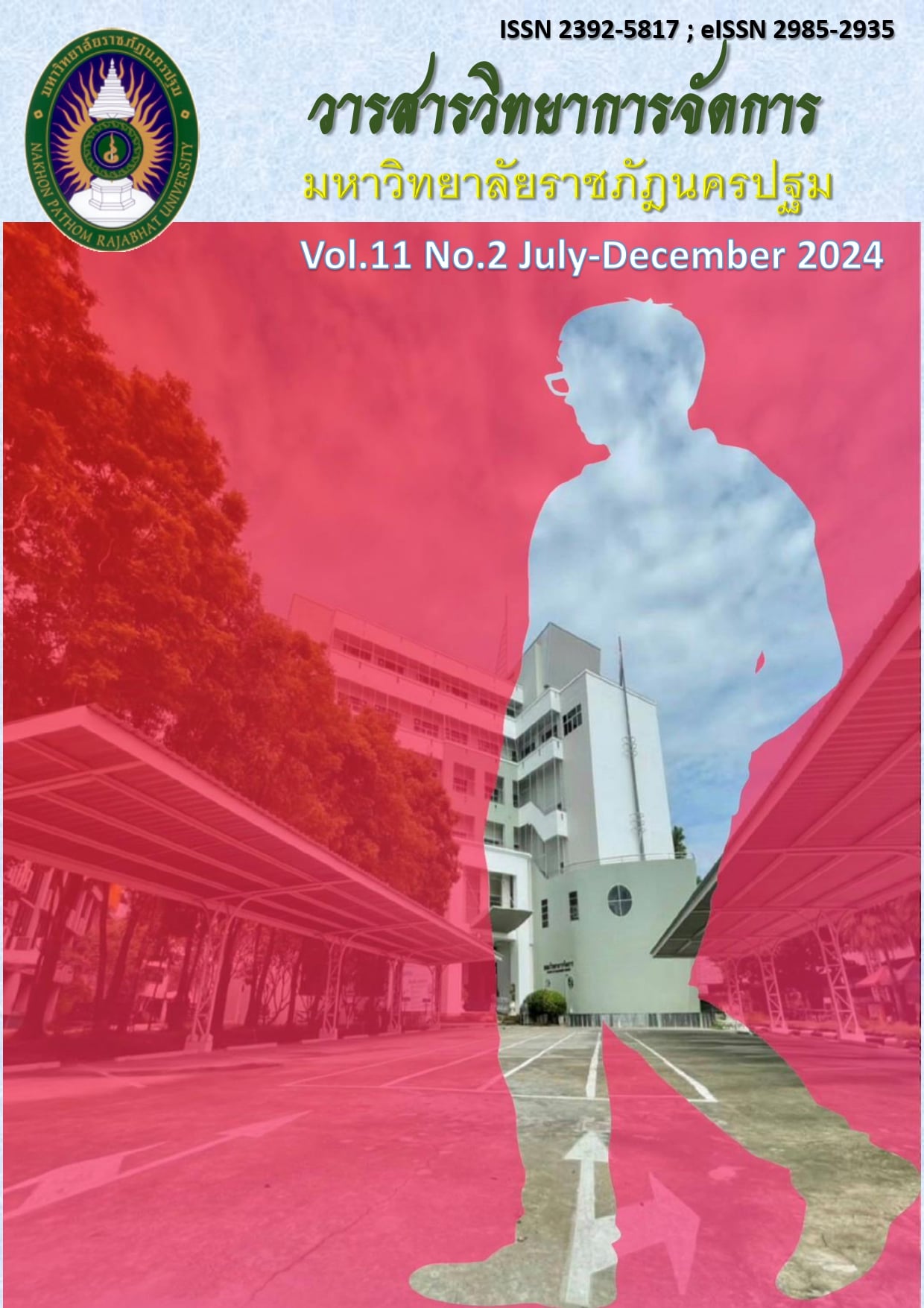Developing financial skills and digital financial literacy to drive investment in the Stock Exchange of Thailand
Main Article Content
Abstract
Article history: Received 28 March 2024
Revised 14 September 2024
Accepted 18 September 2024
SIMILARITY INDEX = 3.84 %
Article Details

This work is licensed under a Creative Commons Attribution-NonCommercial-NoDerivatives 4.0 International License.
The views and opinions of the article appearing in this journal are those of the author. It is not considered a view and responsibility of the editorial staff.
References
ชญานี เรื่องบุญรอด และสิทธิชัย เจริญเศรษฐศิลป์.(2565).ตัวแบบสมการโครงสร้างประสบการณ์ทางการเงิน
ความรู้ทางการเงิน ทัศนคติทางการเงิน และการวางแผนทางการเงินที่มีอิทธิพลต่อพฤติกรรมทาง
การเงินของพนักงานธนาคารแห่งหนึ่ง.วารสารเศรษฐศาสตร์และบริหารธุรกิจ มหาวิทยาลัยทักษิณ.
(4). 139 -157
ตลาดหลักทรัพย์แห่งประเทศไทย.(2566). แผนกลยุทธ์ระยะ 3 ปี (2566-2568). [ออนไลน์] ค้นเมื่อ 15
มีนาคม 2566 จาก https://www.set.or.th/th/about/setsource/news-release/article/150-
set-2023-strategic-plan
ธนาคารแห่งประเทศไทย.(2565 ก). ทิศทางการพัฒนาสู่ความยั่งยืนด้านสิ่งแวดล้อมภายใต้ภูมิทัศน์ใหม่ภาค
การเงินไทย.มปท.: BOT Direction Paper on Financial Landscape.
ธนาคารแห่งประเทศไทย.(2565 ข). รายงานผลสำรวจ ทักษะทางการเงินของไทย ปี 2565, [ออนไลน์] ค้น
เมื่อ 15 มีนาคม 2566 จาก https://www.bot.or.th/content/dam/bot/image/research-and-
publications/2565ThaiFLsurvey.pdf
กระทรวงการคลัง.(2565,) แผนปฏิบัติการด้านการพัฒนาทักษะทางการเงิน พ.ศ. 2565 – 2570. มปท.:
กระทรวงการคลัง
พันธนันท์ บุญมา และวัตสาตรี ดิถียนต์.(2565). ความสัมพันธ์ระหว่างรูปแบบสื่อดิจิทัลและความรู้ทางด้าน
การเงินของผู้ใช้บริการทางการเงิน.วารสารสถาบันวิจัยพัฒนา มหาวิทยาลัยราชภัฏมหาสารคราม,9
(2). 94-108.
สำนักนโยบายการออมและการลงทุน สำนักงานเศรษฐกิจการคลัง. (2565). ข่าวกระทรวงการคลัง.กลุ่ม
สารนิเทศการคลัง สำนักงานปลัดกระทรวงการคลัง.ร่างแผนปฏิบัติการด้านการพัฒนาทักษะทาง
การเงิน พ.ศ. 2565-2570. ฉบับที่ 85/2565 [ออนไลน์] ค้นเมื่อ 14 มิถุนายน 2565 จาก
www.mof.go.th.
สันติธาร เสถียรไทย.(2565). การเข้าถึงการเงินในยุคดิจิทัล.รายงานผลการสำรวจ”คนยุคดิจิทัล”ไทย.
Sea Insights.หน่วยงานวิจัยด้านเศรษฐกิจดิจิทัลและนโยบายสาธารณะ. ค้นเมื่อ 14 มิถุนายน
จากwww.sea.com/home
Fisher, M., Goddu, M. K., and Keil, F. C. (2015). Searching for explanations: How the Internet
inflates estimates of internal knowledge. Journal of Experimental Psychology:
General, 144(3), 674–687
Hira,T.,and Mugenda,O.(2000).Gender differences in financial perceptions, behaviors and
satisfaction, Journal of Financial Planning, 13(2). 86-92.
Kenan Institute Asia. (2015). Literacy Improvement for better Finance in Thailand.
[Online]. Retrieved December 29, 2022 from: https://thaipublica.org/wpcontent/
uploads/2015/03/1.Citi-LIFT-FL-Research-Report-THAI_Draft.pdf [in Thai]
Lusardi, A., and Mitchell, O.S. (2011). Financial literacy: Implications for retirement
security and the financial marketplace Eds., Oxford: Oxford University Press.
Mendari, A.S., and Soejono, F. (2020). The relationship between basic and advanced financial
literacy index and lecturer financial planning.Journal Dinamika Manajemen, 11(2),
-215.
Minimol, M. C. and Lakshmi, L. (2013). Relationship between financial knowledge, financial
attitude and financial literacy: a study among investors in Kerala. International
Journal of Applied Financial Management Perspectives, 2(4). 699-704.
Ning Tang,and Paula C.Peter.(2015). Financial knowledge acquisition among the young: The
role of financial education, financial experience, and parents’ financial experience.
Financial Services Review,24 (2), 119-137.
OECD. (2017). PISA 2015 Results (Volume IV) : Students' Financial Literacy. Edition 2017:
Vol. 4, Paperback – Large Print.
Parrey S. H., Hakim I. A., and Rather R. A. (2018). Mediating role of government initiatives and
media influence between perceived risks and destination image: A study of conflict
zone. International Journal of Tourism Cities, 5(1), 90–106.
Soejono and Mendari,(2019).Literasi Keuangan dosen-dosen perguruan tinggi di Palembang: Factor pendapatan, pendidikan,dan kepemilikan product financial. Journal Management dan Bisnis, 4(1),60-83.


